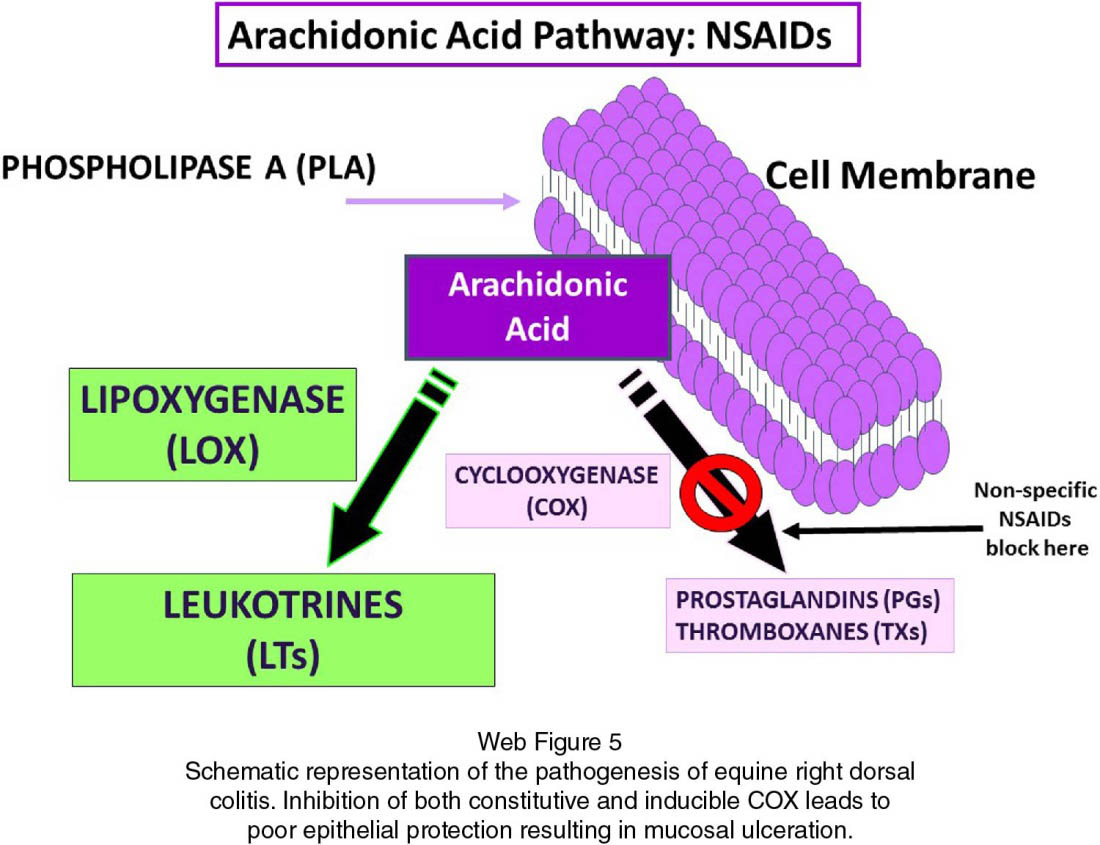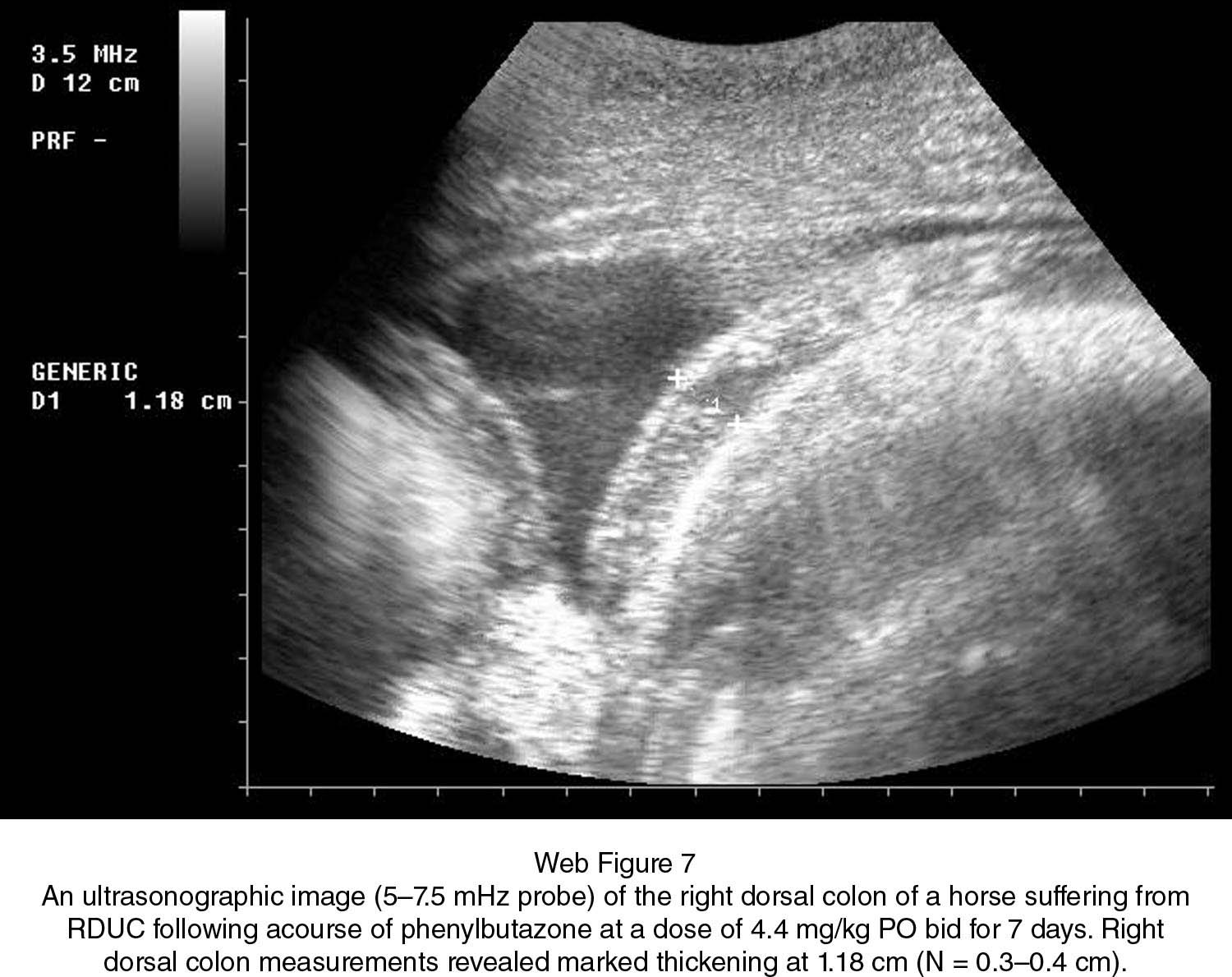- Definition
- Pathophysiology
- Systems Affected
- Genetics
- Incidence/Prevalence
- Geographic Distribution
- Signalment
- Signs
- Causes
- Risk Factors
Localized ulcerative inflammation of the right dorsal colon often associated with administration of NSAIDs, particularly phenylbutazone or flunixin meglumine; dehydration increases the risk of drug toxicity.
- Nonspecific NSAIDs including phenylbutazone and flunixin meglumine inhibit COX activity (Web Figure 1)
as a competitive antagonist for both constitutive COX-1, responsible for the production of PGs involved in physiologic homeostatic functions, and for inducible COX-2, upregulated with inflammation. Intestinal mucosal cell production of PGE2 and PGF2α is decreased by the inhibition of COX-1. This results in the loss of the PG-mediated protective effects on the intestinal mucosa. When the intestinal mucosa integrity is sufficiently compromised, local bacterial invasion of the mucosa, luminal endotoxin absorption, and plasma protein leakage into the intestinal lumen may occur
- NSAID toxicity is potentiated in dehydrated or hypovolemic horses because the normal protective vascular changes guarding from reduced blood flow are inhibited
- The development of RDC in absence of previous NSAID administration suggests that the condition may be multifactorial
- The right dorsal colon is primarily affected. Oral and gastric ulcerations may also develop from NSAID toxicity
- Histologically, lesions are characterized by multifocal to coalescing ulcerations in the wall of the right dorsal colon (Web Figure 2)

- Subacute lesions are characterized by a fibrinonecrotic ulcerative colitis
- In chronic cases, fibrous connective tissue is present in the lamina propria underlying the ulcerated mucosa. Colonic stenosis with ingesta impaction and subsequent necrosis and rupture of the colon can occur
RDC, now preferably called RDUC (U ulcerative), may be associated with the administration of phenylbutazone or other NSAID therapy at the manufacturer's recommended daily dose. The variable toxicity has been attributed to individual variation in response to NSAIDs, duration of treatment, diet composition, health status, age, and hydration status.
Although there is no evidence to demonstrate overrepresentation for any particular age or breed, most reports involve miniature horses, ponies, and young performance horses.
Most cases have a history of administration of oral or parenteral NSAIDs with phenylbutazone being the most commonly used. RDUC can also result following high-dose administration of flunixin meglumine or in combination with phenylbutazone. NSAID therapy is most commonly implemented for treatment of chronic or severe musculoskeletal conditions (i.e. laminitis).
- NSAID toxicity cases commonly present with concurrent systemic dehydration, which may result from either systemic illness or an inability to maintain proper hydration
- Horses with acute disease commonly have clinical signs that include colic, depression, lethargy, partial or complete anorexia, fever, and diarrhea
- Horses with chronic disease may demonstrate intermittent colic, soft feces, weight loss, and ventral edema
- Acute disease is commonly associated with signs of colitis including watery diarrhea, severe dehydration, severe systemic illness, injected mucous membranes and/or marked endotoxemia
- Horses with chronic disease may have formed or soft “cow pie” feces, edema, and abnormal vital parameters that include often elevated heart rate
NSAID toxicity results from high-dose therapy, with individual horses having the ability to tolerate higher NSAID administration doses. It is not clear why ulcerative lesions are localized in the right dorsal colon.
 BASICS
BASICS
 DIAGNOSIS
DIAGNOSIS
 TREATMENT
TREATMENT MEDICATIONS
MEDICATIONS FOLLOW-UP
FOLLOW-UP MISCELLANEOUS
MISCELLANEOUS